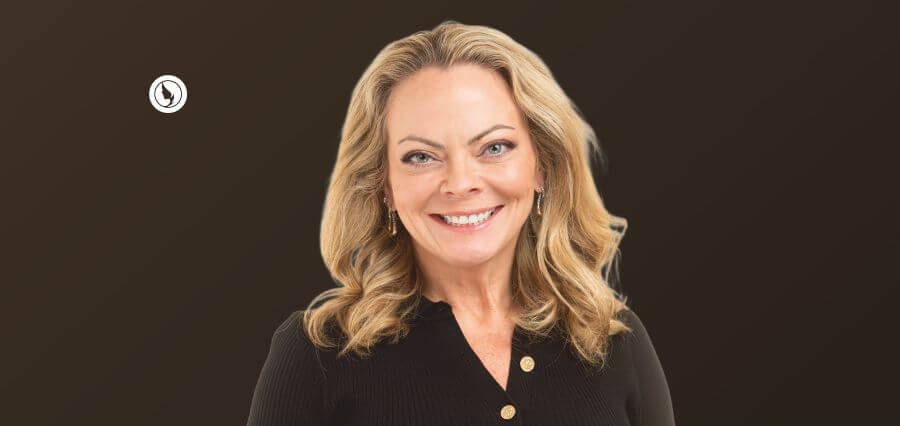Driving Meaningful Change!
Technology continues redefining how businesses connect with audiences by integrating data-driven strategies and AI. As the digital sector grows more challenging, ad tech has become necessary to optimize campaigns, ensure precision targeting, and enhance overall marketing efficiency. Its significance lies in its ability to streamline processes, deliver personalized experiences, and adapt to emerging trends. These advancements support businesses in achieving their goals and elevate consumer engagement, creating a vibrant ecosystem where technology drives impactful outcomes. This progressing sector demonstrates the growing demand for innovative approaches to address challenges and unlock new opportunities in advertising.
Stephanie Dorman, Chief Customer Officer, has become a key influencer in transforming advertising and technology. Her leadership reflects adaptability and a deep commitment to nurturing trust within her teams. Stephanie’s approach empowers individuals, encourages open communication, and values diverse perspectives. She has successfully guided teams through industry shifts by promoting inclusivity and accountability while focusing on collaborative problem-solving. Her ability to inspire confidence and align team efforts toward achieving shared goals underscores her impact on driving meaningful change across the sector.
Mediaocean, a recognized leader in advertising technology and infrastructure, has consistently set benchmarks for operational excellence and innovation. The company’s recent transition to a unified customer service model showcases its dedication to enhancing user experiences while streamlining processes. Mediaocean has expressed how thoughtful process optimization can improve customer satisfaction and efficiency by strategically integrating teams and adopting advanced AI tools. By focusing on continuous improvement and aligning technological advancements with customer needs, Mediaocean has cemented its position as a driving force in ad tech, enabling businesses to steer challenges and succeed in an increasingly competitive market.
Let’s explore Stephanie’s innovative leadership approaches:
Embracing Diversity of Thought and Skills
Over the years, Stephanie has adhered to the principle of continuous improvement. Even when her teams achieved peak performance, she treated those moments as opportunities to grow and adapt. This approach has consistently driven results, ensuring her teams remain agile, relevant, and innovative in rapidly changing environments. Beyond the process, she has also underscored trust and open communication. High-performing teams are built on shared values, mutual respect, and the collective pursuit of goals. They have sustained exceptional performance by nurturing these qualities and creating a foundation for long-term success.
Another essential practice is encouraging diversity of thought and skills. High-performing teams excel because of their differences; each member brings unique strengths, experiences, and perspectives. This diversity not only fuels innovation but also enhances problem-solving and decision-making capabilities. By valuing these differences and encouraging collaboration, Stephanie has been able to unlock the full potential of her teams.
Finally, she focuses on empowering team leaders. Leadership isn’t confined to titles; it’s about cultivating a sense of responsibility and ownership at all levels. When team members feel trusted to lead initiatives and make decisions, they become more invested in the outcomes, driving individual and collective growth.
Transition to Unified Customer Service Model
Mediaocean’s recent transition from function-based teams to a unified, customer-vertical-based structure was a standout example of streamlining operations. Previously, account management, relationship managers, and support professionals operated independently. While each function excelled, it was found that 60% of their tasks overlapped. Integrating these teams created a model that offered customers more consistent and holistic service.
This shift coincided with the rollout of new AI technologies, which added intricacy to the transition. Integrating teams and adopting new tools resulted in a remarkable 98% customer satisfaction rate by year-end, exceeding expectations and proving the model’s success.
Key efficiency metrics also improved, including faster issue resolution times, fewer escalations, and higher employee engagement due to clearer roles and responsibilities. The changes streamlined workflows, reduced redundancies, and enhanced collaboration across previously disconnected teams, demonstrating the value of a proactive approach to process optimization.
Creating a Collaborative Environment
Stephanie believes empowering employees starts with creating a collaborative environment where everyone’s voice matters. She stresses shared leadership and encourages input from all levels, regardless of whether the topic falls within someone’s direct responsibility. This inclusivity promotes innovation, accountability, and a sense of ownership among team members.
One of the most effective methods is allowing employees to participate in significant initiatives and decision-making processes. For instance, during the implementation of AI-driven tools like chat and knowledge-base enhancements, the team’s collective input shaped the rollout process. Employees from various functions contributed insights, helping refine strategies and adapt quickly.
As a result, the rollout enhanced tool functionality and strengthened team confidence in steering complicated challenges. Employees felt their voices were heard and valued, creating a culture of empowerment that drives innovation and high performance. Ultimately, this approach yielded measurable success, including faster tool adoption and improved customer satisfaction.
Cross-Departmental Perspectives on Performance
Achieving fairness and consistency in performance assessments requires a rigorous and inclusive process. Mediaocean’s evaluations occur twice yearly, first at mid-year and again at year-end. Individual leaders conduct initial reviews for their teams, followed by a collaborative leadership session to perform a nine-box exercise. This exercise brings together insights from across departments, ensuring a well-rounded view of each employee’s contributions.
The collaborative nature of this process is key. Leaders share observations about employees they interact with outside their direct teams, offering a broader perspective on performance. After the exercise, senior leaders cross-check evaluations to ensure alignment and accuracy. This final step ensures that feedback is fair and supported by specific examples.
The outcomes of this process go beyond just performance evaluations; they help identify high-potential employees, align development opportunities with career aspirations, and ensure that assessments drive actionable growth plans. By adopting this structured approach, Mediaocean provides actionable insights that drive personal and professional growth while maintaining organizational alignment.
Aligning Team Goals with Corporate Initiatives
According to Stephanie, effective alignment starts with clear communication and shared leadership. Mediaocean aligns team goals with corporate initiatives every year, ensuring each functional area understands its role in the broader strategy. Organizational plans are developed collaboratively and communicated in all-hands meetings, where updates and feedback keep everyone engaged and informed.
Mediaocean relies on a central customer operations team to encourage collaboration. This team acts as a connective hub between departments, ensures efficient workflows, minimizes redundancies, and utilizes strengths across functions. For example, when implementing new service models, Mediaocean worked closely with this team to synchronize support, account management, and operations efforts. By embedding alignment into daily operations, Mediaocean creates an environment where functional areas work cohesively toward shared objectives.
Regular feedback loops are also integral. By incorporating cross-functional feedback during strategic reviews, Mediaocean ensures that every team is aligned with and operates in concert with the broader corporate vision. This structure reinforces collaboration and ensures that all areas contribute effectively to the goals.
Personalized Communication in Change Management
For Stephanie, quick execution is essential in challenging environments but must be balanced with calculated risk-taking and strong change management. The first step is embracing imperfection during the initial stages of change. Acting quickly often provides opportunities to test, learn, and refine as we go. This iterative approach reduces the paralysis that can accompany striving for perfection upfront.
Robust change management is equally critical. Mediaocean’s team prioritizes personalized, transparent communication, ensuring employees feel supported throughout transitions. For example, standard all-hands meetings are complemented by AMA sessions during significant organizational changes where questions can be submitted anonymously or asked openly. These forums encourage transparency and open dialogue, address concerns, and build trust. By combining informed risks with thoughtful communication, Mediaocean achieves meaningful change while minimizing disruption and resistance.
Integrating Customer Insights into Decision-Making
Aligning customer experience with business objectives involves integrating customer insights into decision-making and encouraging team collaboration. A key focus has been personalizing communication during change initiatives, ensuring transparency, and involving customers early. For example, when implementing new technologies, feedback was gathered to refine strategies, build trust, and enhance satisfaction. One notable outcome was improving collateral by implementing more robust keywords for contextual searches.
Mediaocean’s cross-functional collaboration model ensures that every team, whether in support, account management, or operations, contributes to delivering consistent, value-driven experiences. Efforts were aligned to improve service delivery and drive growth during transitioning to a customer-vertical-based support structure. Integrating customer focus with organizational goals has been essential in achieving success.
Holistic Approach to Career Development
Stephanie reflects that career pathing involves creating opportunities that align with employee aspirations and organizational needs. Mediaocean has adapted to generational shifts by valuing titles and creating new roles to meet emerging business demands. For instance, cultures were blended during acquisitions to offer employees meaningful growth opportunities rather than forcing them into rigid structures.
Mediaocean measures success using quantitative metrics such as engagement scores, retention rates, and promotion rates, complemented by qualitative feedback from performance reviews and surveys. This combination ensures career development is addressed holistically, creating a culture where employees feel valued and excited about their future.
Enhancing Engagement and Efficiency Internally
Creative resourcing has been a key approach to overcoming skill gaps and resource constraints. The first step is maximizing the tools and talent already available within the organization. Rather than seeking new external solutions for every challenge, Mediaocean focuses on adapting workflows and fully utilizing existing technologies. This saves costs and encourages innovation as teams find new ways to use current resources.
One example is Mediaocean’s approach to technology partnerships. Instead of continually onboarding new tools, Mediaocean deepens relationships with existing vendors, ensuring the functionality of their products is maximized. This strategy has enhanced productivity without overextending budgets.
On the people side, internal talent development is highlighted. When a gap in operational efficiency was identified, a new customer operations team was created. Employees with the right mindset and skill set were found to transition into these roles by looking internally. They were then provided with growth opportunities while solving organizational challenges. This method increases engagement, reduces onboarding time, and ensures high productivity while addressing business needs.
Commitment to Operational Excellence and Customer Satisfaction
Stephanie highlights that migrating to a unified technology platform presents a significant challenge and a transformative opportunity. This initiative is essential for future-proofing operations and ensuring Mediaocean continues to meet customers’ growing needs. The intricacy lies in balancing the transition with ongoing day-to-day responsibilities. This isn’t just a technical upgrade; it involves retraining teams, shifting workflows, and ensuring continuity for long-term customers, some of which have been using the systems for over five decades.
The stakes are high, as the migration affects every user globally. Success requires meticulous planning, prioritization, and clear communication. Teams need to manage the technical aspects and customer relationships during this transition. Customers must feel confident in the process, which requires transparency and proactive engagement.
The opportunity is immense. By completing this migration, Mediaocean solidifies its position as a leader in the advertising and technology space. This modernized platform enables greater integration, innovation, and scalability, aligning with customer expectations for flexibility and efficiency. Ultimately, this transition positions Mediaocean to provide even greater value while maintaining its commitment to operational excellence and customer satisfaction.




